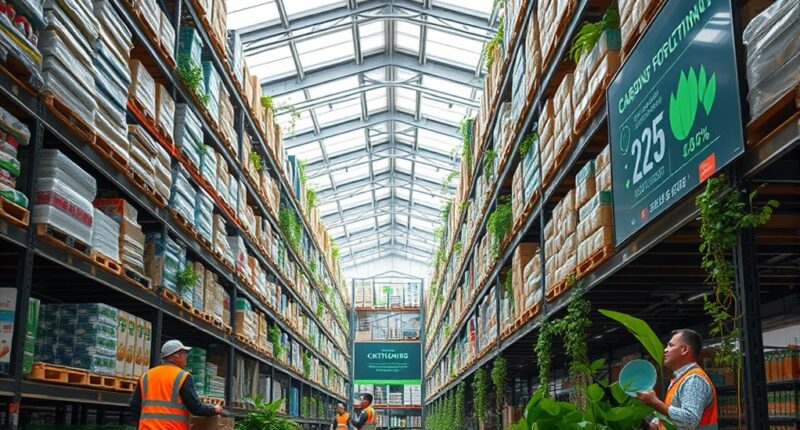Integrating sustainability into your supply chain helps you balance profit with environmental and social responsibility. You can do this by analyzing each step to identify areas with high emissions, switching to renewable energy, optimizing logistics, and choosing ethical suppliers. Transparency with stakeholders shows your commitment and boosts long-term resilience. If you keep exploring, you’ll discover practical strategies to embed sustainability seamlessly into your supply chain operations for lasting benefits.
Key Takeaways
- Establish clear, measurable sustainability goals aligned with overall business strategy.
- Engage suppliers early and promote sustainable practices through transparent communication.
- Analyze supply chain activities to identify and reduce high-emission areas effectively.
- Incorporate ethical sourcing standards and certifications to ensure social and environmental responsibility.
- Leverage technology and data tracking to monitor, report, and improve sustainability performance continuously.

Supply chain sustainability has become a critical focus for businesses aiming to balance profitability with environmental and social responsibility. As you look for ways to make your supply chain more sustainable, you need to understand how your choices influence the planet and communities. One of the most significant factors is your carbon footprint—the total greenhouse gases emitted directly or indirectly during production, transportation, and distribution. Reducing this footprint isn’t just good for the environment; it also enhances your brand’s reputation and can lead to cost savings. You can start by analyzing each step of your supply chain to identify where emissions are highest and explore alternatives like shifting to renewable energy sources, optimizing logistics routes, or choosing suppliers with lower emissions.
Reducing your supply chain’s carbon footprint boosts sustainability, saves costs, and enhances your brand reputation.
Ethical sourcing plays a pivotal role in integrating sustainability into your supply chain. It involves selecting suppliers that adhere to fair labor practices, respect human rights, and operate with transparency. By prioritizing ethical sourcing, you ensure that your products are made without exploiting workers or damaging communities. This approach not only aligns with corporate social responsibility goals but also mitigates risks related to supply chain disruptions caused by unethical practices. When you establish strong relationships with ethical suppliers, you create a more resilient supply chain that reflects your company’s values and builds consumer trust. You might also consider certifications like Fair Trade or B Corp, which verify that suppliers meet high standards of social and environmental performance.
Incorporating sustainability into your supply chain requires a deliberate strategy. Start by setting clear goals, such as reducing your carbon footprint by a specific percentage within a set timeframe or increasing the percentage of ethically sourced materials. Engage your suppliers early in these efforts, encouraging them to adopt sustainable practices and providing support where needed. Communication is key—make sure your expectations are transparent, and collaborate to find innovative solutions. Technology can help streamline this process; tools like supply chain management software enable real-time tracking of emissions and compliance with ethical standards. Additionally, understanding the Eye Patch Benefits can serve as a reminder that even small, targeted efforts can improve overall well-being and operational efficiency.
Lastly, remember that transparency with stakeholders is essential. Sharing your progress not only demonstrates your commitment but also encourages industry-wide change. As you integrate sustainability into your supply chain, you make a positive impact on the environment and society, while also strengthening your company’s long-term resilience and competitiveness. The journey requires effort and commitment, but the benefits—reduced costs, improved reputation, and a healthier planet—are well worth it.
Frequently Asked Questions
How Can Small Businesses Implement Sustainable Supply Chain Practices?
You can implement sustainable supply chain practices by collaborating closely with your suppliers to guarantee eco-friendly sourcing. Build strong relationships to encourage transparency and shared sustainability goals. Opt for eco-friendly materials and prioritize suppliers with green certifications. Regularly assess your supply chain’s environmental impact and seek ways to reduce waste and emissions. By actively engaging your suppliers and making conscious sourcing choices, you’ll create a more sustainable, responsible supply chain that benefits your business and the planet.
What Are the Cost Implications of Adopting Sustainable Supply Chain Strategies?
Adopting sustainable supply chain strategies involves initial investment challenges that can increase your costs upfront. A thorough cost analysis helps you understand these expenses versus long-term savings, such as reduced waste and energy efficiency. While the upfront costs might seem high, sustainable practices often lead to lower operational costs over time, boosting your competitiveness. Be prepared for investment challenges, but recognize that sustainable supply chains can enhance your brand and profitability in the long run.
How Do Regulations Influence Sustainable Supply Chain Development Globally?
Regulations considerably influence your sustainable supply chain development by enforcing regulatory compliance and aligning with international standards. When governments or global bodies set strict environmental and social rules, you’re compelled to adapt your practices, which can increase costs but also boost your reputation. These regulations drive innovation, ensuring your supply chain remains competitive and responsible. Staying updated on international standards allows you to seamlessly meet compliance, fostering sustainability and global trust in your operations.
What Role Do Technology and Innovation Play in Supply Chain Sustainability?
You play a vital role in supply chain sustainability by leveraging technology and innovation. Did you know that companies using digital transformation and data analytics see a 15% reduction in carbon emissions? These tools help you track and optimize resources, identify inefficiencies, and make smarter decisions. Your adoption of innovative solutions accelerates sustainability efforts, making supply chains more eco-friendly and resilient, ultimately contributing to a greener future.
How Can Companies Effectively Measure Sustainability Performance in Their Supply Chains?
You can effectively measure sustainability performance in your supply chain by tracking your carbon footprint regularly and setting clear reduction targets. Engage stakeholders at every level to gather insights and foster accountability. Use transparent reporting and data analytics to monitor progress, identify areas for improvement, and make certain your sustainability efforts align with your overall business goals. This approach helps you create a more sustainable, responsible supply chain.
Conclusion
By integrating sustainability into your supply chain, you not only reduce environmental impact but also boost your company’s resilience. Did you know that 73% of consumers prefer brands committed to sustainability? Embracing eco-friendly practices can set you apart and drive long-term success. So, start today—your supply chain’s future depends on it. Making sustainable choices isn’t just good for the planet; it’s smart business.









